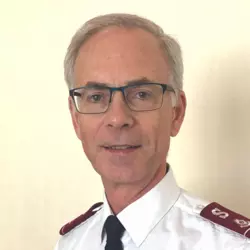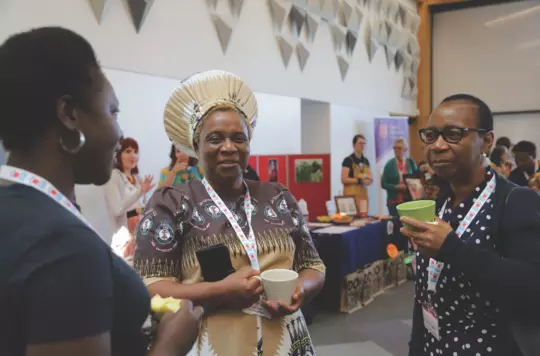4 January 2023
Being churches together
Lieut-Colonel Jonathan Roberts

Lieut-Colonel Jonathan Roberts asks Mike Royal about himself and his role as general secretary of Churches Together in England.
What is your background?
My parents came to the UK in the late 1950s, as many people from the Caribbean did, to help rebuild the country after the Second World War. I was born and brought up in Purley, near Croydon, and came to personal faith aged 14.
I trained as an urban planner and worked in that sector for about three years before being called into church ministry. I spent 10 years in Keighley, West Yorkshire, as a district pastor of two churches. During that time I served for four years as the national youth leader of the Apostolic Church UK and started a charity called Transforming Lives for Good.
I moved to Birmingham and was appointed as national director of the charity. Over the next 11 years, I was involved in helping them plant alternative education centres around the UK in partnership with churches. One of those was The Salvation Army’s Aston 614 youth centre in Birmingham.
Then for a few years I was involved with Cinnamon Network, helping churches engage with their communities. I was co-chief executive officer for three years before being appointed as general secretary of Churches Together in England (CTE) in March this year.
What attracted you to the CTE role?
There weren’t many things that could have pulled me away from Cinnamon. As well as working with individual churches, we helped groups of churches think about how they could serve their communities together. That prepared me well for CTE, which involves deeper conversations about what unity looks like. So this was one of the few roles that really lit my fire, and I had a real sense of being called to it.
Enabling the Church to be the hands and feet of Jesus – that is what gets me out of bed!
What are your responsibilities?
My priority is to be a point of reference for the 52 denominations that relate to CTE. That includes engaging with churches – their conferences, synods, leadership and decision-making gatherings – and understanding the direction they’re taking and the impact it has on the way they relate to other churches.
Across the country there are also county ecumenical officers and denominational ecumenical officers, so I have quite a lot of meetings with those. Then, of course, we have the six CTE presidents representing the major traditions of each of our member churches: Anglican, Catholic, Free Church, Pentecostal and Charismatic, Orthodox and one who represents Quakers, Lutherans and others. Some of those presidents need my support and service.

I also have a team of seven people, which I am leading through a time of transition to make sure that we are fit for purpose.
What is the main purpose of CTE?
It is to help fulfil the scriptural mandate that Jesus gave us in John 17:21 – that we all might be one as he and the Father are one. It means facilitating churches’ relationships with each other. It’s also about amplifying their voices, particularly when they want to speak out in unity on a particular issue.
For example, on the issue of Ukraine we were able to formulate words that could then be put out to the press. And at the Ukraine refugee roundtable a number of churches asked questions that I was able to put to Michael Gove, the then secretary of state for housing, communities and local government. There’s our Racial Justice Working Group, with different churches working together around campaigning, theology and racial justice, and there’s other work as well. We are an instrument that enables churches to come together, dialogue and frame things in unison.
How does CTE relate to other national ecumenical bodies?
I’m pleased to say I’m forming a good relationship with Dr Nicola Brady, who leads Churches Together in Britain and Ireland. CTBI’s role is slightly different. Its focus is on issues such as refugees and climate change. It also specialises in creating resources for churches, whereas CTE is a bit more specialised in bringing churches together in dialogue. So it’s important we work in tandem.
Then, of course, there’s Cytûn (Churches Together in Wales), which is delivering some great stuff, particularly around refugees. There’s also Action of Churches Together in Scotland. Relating to all these bodies is really important. Because the English situation has so many county and local ecumenical bodies, people do look to CTE to lead the way in terms of church engagement. But we also need to respect and learn from what’s happening in the other nations within Britain and Ireland.
What is happening at the county and local levels?
Our principal officer for ecumenical development and relations supports unity at both intermediate and local levels. Sometimes that is about giving advice to support a local ecumenical officer. Sometimes it’s being a gentle presence in the background. One of the challenges is making sure that the apparatus behind intermediate ecumenism is appropriate and is not suffering from inertia. We are scanning good practice from around the country, so will be well placed to advise intermediate bodies on how they might tweak their processes to be relevant.
What is the state of the churches in England?
I don’t think there is a denomination that would not be able to point to beacons of hope in particular parts of the country. Each denomination has churches that are all that the Church should be in a local community. At the same time, a lot of churches are languishing. Some are on the verge of closure, and denominations are having to manage that alongside facilitating and supporting those beacons of hope.
I would say that the Pentecostal and Charismatic churches, and some of the migrant churches that are springing up, are breathing new life into the Church generally. There are definitely signs of hope but also, particularly with some of the historic denominations, some real challenges.
How can ecumenical engagement help to revitalise churches?
I do think that we are better together. Pastor Les Isaac, the founder of Street Pastors, was someone who mentored me. He used to say, ‘For too long you’ve been in your bomb shelter and I’ve been in mine.’ We can have our heads in what we’re doing, but when churches look up and look outwards and begin to connect with what others are doing, it is far better. The most relevant aspects of ecumenical working are around social action. The Salvation Army probably has the best history of social action of any denomination. Helping churches to do that well, and do that together, is really important.
How do you see The Salvation Army’s place among other churches?
I am so excited about the part that The Salvation Army plays in the life of CTE. I am particularly excited about the number of young emerging leaders from your denomination who are engaging with us. They really lit up our recent forum.
We have to get the overall age of people engaging ecumenically down so that our churches have the future they deserve. The ecumenical engagement of your young leaders is an example of the way ahead for many other denominations.
- Find out more about Churches Together in England at cte.org.uk
Written by

Lieut-Colonel Jonathan Roberts
Territorial Ecumenical Officer

Supporting and developing the ecumenical and interfaith work of The Salvation Army.

A collection of posters and flyers translated in a number of languages that can be used in your corps or centre.

Celebrating and embracing ethnic and cultural diversity within The Salvation Army.
